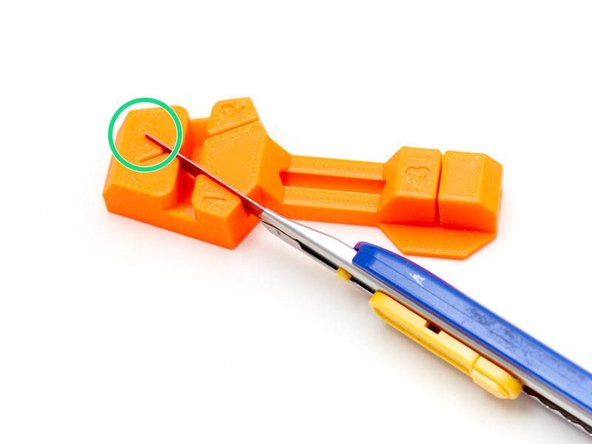-
-
You will need the following tools:
-
PTFE cutting jig. If you are building the Bear extruder use the one included with the printed parts. If you are cutting a PTFE tube for another extruder, check our files here: thingiverse.com/thing:3749528
-
Box cutter with a blade thickness of approximately 0.4 mm. Verify that the blade can be fully inserted in each of the jig's slits.
-
60° countersink.
-
Unused PTFE tube of at least 100mm.
-
For information, Prusa specifications for PTFE tubes are available here : How to trim PTFE tube - Original Prusa i3 printers. For BearExxa build you have to use the length mentioned in the BearExxa assembly guide.
-
Always be very careful when using a box cutter, you could inflict serious injury to yourself. Take your time and wear protective gloves if necessary.
-
-
-
60° countersinks could have different shapes. Here are some examples to help you find one. If you really can't find one then use a standard 45° countersink.
-
First image is an example of standard 60° countersink:
-
The outer diameter must be in the range of 4.5 to 6.5mm.
-
The second image is an example of center drill bit which is generally at 60°:
-
The outer diameter must be in the range of 4.5 to 6.5mm.
-
The diameter at the end must be less than or equal to 1.5mm.
-
The third image is an example of a 60° CNC milling cutter:
-
The outer diameter needs to be in the range of 4.5 to 6.5mm.
-
-
-
Make sure your PTFE tube has a flat and perpendicular end. If this is not the case, use the end (number 3) of the PTFE cutter jig to make it straight.
-
-
-
Insert the box cutter blade in the PTFE cutter jig in the slit number 1.
-
Verify that the blade is at the bottom of the slit and parallel to bottom of the jig.
-
In order to protect your fingers, make sure the blade is fully inserted as seen in the image.
-
-
-
Hold the blade in the PTFE cutter jig with your thumb.
-
Insert the PTFE tube all the way in the cutter jig until it is pressed against the end stop.
-
Rotate the tube clockwise (looking from the back of the cutter jig) to chamfer the end.
-
Rotate few turns. It should create nice chips of PTFE.
-
Sometimes it can be difficult to turn the PTFE in the cutter jig. In this case, here are some tricks to make it easier:
-
Use a longer PTFE tube
-
Add a filament inside the PTFE
-
Use a kitchen glove
-
-
-
Remove the blade from slit number 1.
-
Insert the blade in slit number 2.
-
Verify that the blade is at the bottom of the slit and parallel to the bottom.
-
To protect your fingers, make sure the blade is fully inserted (refer to previous steps in case of doubt).
-
While holding the blade with your thumb, insert the PTFE tube all the way in the cutter jig until it is pressed against the end stop.
-
This time you need to rotate the tube counter-clockwise (looking from the back of the cutter jig).
-
-
-
Keep the PTFE inside the jig and trim the length. Make sure the PTFE is fully seated and does not move while making the cut.
-
-
-
On the flat side of the PTFE, make a chamfer with the 60° countersink tool.
-
The completed chamfer should look like the second image.
-
You can insert the PTFE tube into the cutting tool so that the flat end protrudes slightly. It can be held in place by pressing on the center of the tube.
-
-
-
Pass a piece of filament through the trimmed PTFE tube to clean any residual PTFE chips.
-
Cancel: I did not complete this guide.
7 other people completed this guide.














